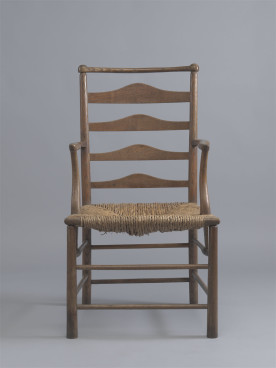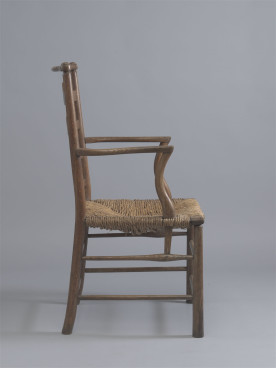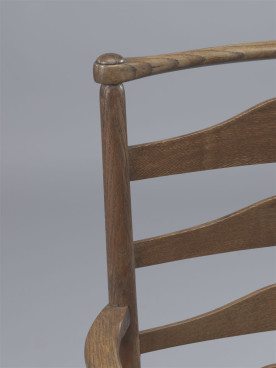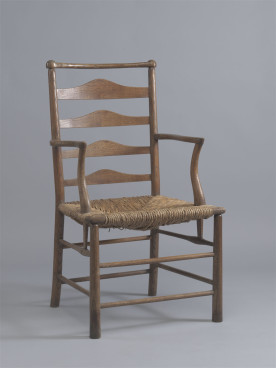Armchair, c.1900
Oak and rush
This chair was designed by C.R. Ashbee for the dining room at the Magpie and Stump, 24 Cheyne Walk, London, the house that Ashbee designed for his mother. It was probably made by the Guild of Handicraft, London, and it is one of a pair from a larger set.
Adam Bowett Catalogue 14/08/2012
Description
A pair of armchairs, c.1900. The ladder backs have four shaped ‘rungs’ and are tied by a flat rail set on top of the posts. The slender, out-curved arms rest on curved supports, and the rush seats are raised on turned and inversely tapered legs joined by paired stretchers.
Dimensions
H: 38”(97cm) Seat height: 17” (43cm) W: 21 ½ “ (54cm) D: 21“ (53cm)
Designer/Maker
Charles Robert Ashbee
Materials
Oak and rush
Dating Criteria
Design by C.R. Ashbee. Similar chairs were designed by Ashbee for his house in Chelsea, The Magpie and Stump. Much of Ashbee’s furniture was made by craftsmen of the Guild of Handicraft.
Construction
The ‘rungs’ in the back are tenoned into the back posts and the tie rail is presumably socketted on to the top of the posts and secured with a glued oak ‘button’. The arms are fixed to the post with a plugged screw and either mortised or dowelled into the arm supports. The arm supports extend through the side rails of the seat and are tenoned into the stretcher below. The front legs are dowelled up into the corners of the seat; the seat rails are dowelled in to the rear posts and tenoned into the front corner blocks; all the stretchers are dowelled into the legs.
Condition
46.1 Basically sound. There is a repaired break to the right hand arm support, now glued and nailed, and there are repairs where both arm support extensions mortised into the side stretchers. The rush seating is probably replaced.
46.2 Sound, all original except for one replaced rear stretcher and replaced rush seat.
Additional remarks
The rather loose rushing suggests it is replaced. Original rush seats tended to be tightly woven with a finer gauge of rush. The chair is modelled on vernacular ladder-back chairs made in several parts of Britain in the 19th century. Variants of the arm support, with its extension below the seat, occur on the ‘Sussex’ range of chairs produced by Morris, Marshall, Faulkner &Co., as well as on vernacular chairs.
Provenance
Purchased from Haslem and Whiteway, June 2006














